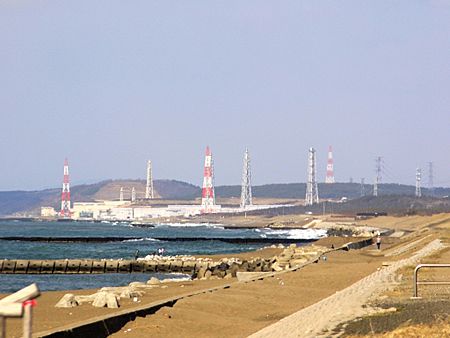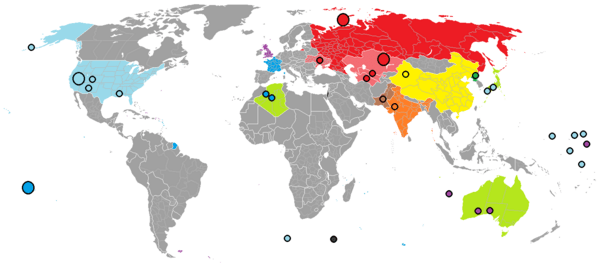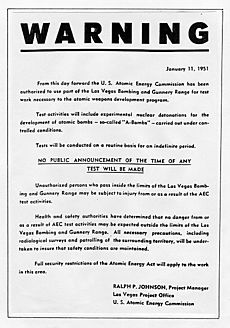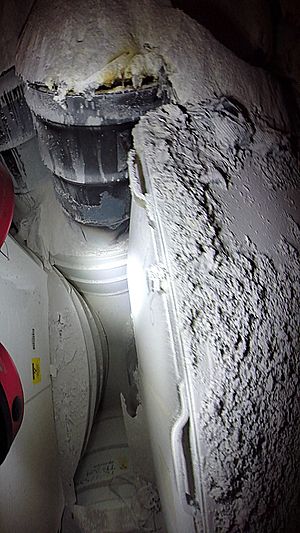Nuclear and radiation accidents and incidents facts for kids
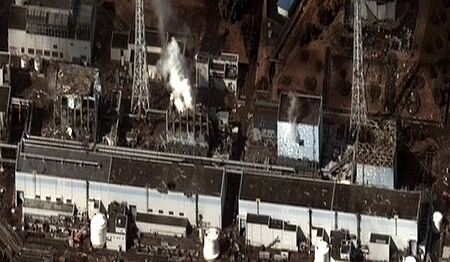
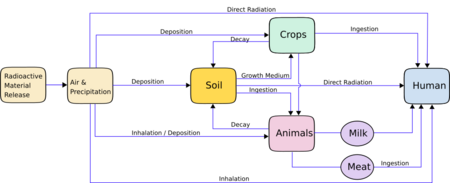
A nuclear and radiation accident is an event that causes serious harm to people, the environment, or a facility. This could include health problems for individuals, a large release of radioactivity into the environment, or damage to a reactor's core. A major nuclear accident happens when a reactor core is damaged and a lot of radioactive materials are released. Famous examples are the Chernobyl disaster in 1986 and the Fukushima nuclear accident in 2011.
People have debated the safety of nuclear power since the first nuclear reactors were built in 1954. This concern has led to many safety improvements. However, mistakes can still happen. There have been over 100 serious nuclear accidents and incidents since nuclear power began. About 60% of these have happened in the USA. Some serious power plant accidents include Fukushima nuclear accident (2011), Chernobyl disaster (1986), Three Mile Island accident (1979), and the SL-1 accident (1961). These accidents can cause deaths and cost a lot of money to clean up.
The International Atomic Energy Agency (IAEA) keeps a website that reports recent nuclear accidents. In 2020, the World Health Organization (WHO) noted that the mental and emotional effects of these accidents can be even greater than the direct physical harm from radiation.
Contents
- Understanding Nuclear Plant Accidents
- Protecting Nuclear Reactors from Attacks
- Understanding Radiation and Other Incidents
- Nuclear Weapons Testing Around the World
- Keeping Nuclear Materials Safe
- Types of Nuclear Accidents
- Comparing Energy Safety Records
- Ensuring Nuclear Safety
- Ecological Impacts of Accidents
- Impact on People
- See also
Understanding Nuclear Plant Accidents
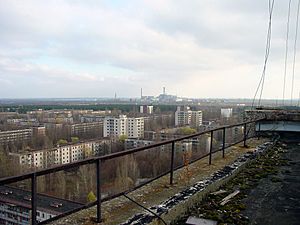
The world's first nuclear reactor core meltdown happened in 1952 at the NRX reactor in Canada.
The most severe nuclear accident to date was the Chernobyl disaster in 1986 in Ukraine. This accident directly caused about 30 deaths and damaged property worth billions of dollars. A 2005 study by the World Health Organization suggested that up to 4,000 additional cancer deaths might eventually be linked to the accident among those exposed to high radiation levels. Other studies have suggested higher numbers. Radioactive fallout mainly affected Belarus, Ukraine, and Russia. About 350,000 people had to move away from these areas. Cleanup efforts involved 6,000 people, and a large area of land was contaminated.
Many accidents have happened at nuclear power plants worldwide. From 1952 to 2009, there were 99 accidents that either caused deaths or more than US$50,000 in damage. These accidents cost a total of US$20.5 billion. Thankfully, few people have died directly from these power plant accidents.
Protecting Nuclear Reactors from Attacks
Nuclear power plants and other nuclear facilities need strong protection from deliberate attacks. These attacks could cause a lot of radioactive contamination. Threats include ground attacks on equipment, aircraft crashes into a reactor, or cyber attacks.
The 9/11 Commission in the United States found that nuclear power plants were considered as possible targets for the September 11 attacks. If terrorists could damage safety systems enough to cause a core meltdown or damage spent fuel storage, it could lead to widespread radioactive contamination. Experts say that if nuclear power grows, facilities must be extremely safe from attacks. Newer reactor designs include passive nuclear safety features, which can help. In the U.S., the Nuclear Regulatory Commission (NRC) regularly tests security at nuclear power plants.
Nuclear reactors have sometimes been targets during wars. For example, in March 2022, the Battle of Enerhodar caused damage to the Zaporizhzhia Nuclear Power Plant in Ukraine. This raised serious concerns about nuclear contamination. In September 2022, the IAEA called for a special protection zone around the plant to ensure its safety.
Understanding Radiation and Other Incidents
Besides power plant accidents, there have been other serious radiation incidents. These include accidents involving nuclear submarines, or when radioactive materials used in medicine or industry are mishandled.
Some notable incidents include:
- The Kyshtym disaster in 1957 in the Soviet Union, where a chemical explosion at a nuclear fuel plant released radiation.
- The Windscale fire in 1957 in the UK, where a reactor fire released radioactive iodine.
- The Goiania accident in 1987 in Brazil, where a forgotten medical radiation source caused serious contamination.
- The Mayapuri radiological accident in India in 2010, where a research device was sold as scrap metal.
These events show how important it is to handle radioactive materials with extreme care.
Nuclear Weapons Testing Around the World
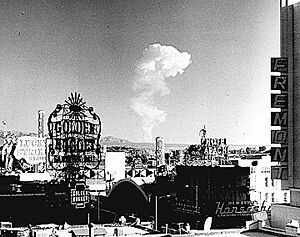
Between 1945 and 1992, many countries, especially the United States and the Soviet Union, conducted over 2,000 nuclear weapons tests. These tests often happened in the atmosphere, meaning above ground. This caused nuclear fallout to spread, exposing many people to radiation.
For example, the 1954 Castle Bravo test in the Pacific spread fallout over many islands. The full impact of these tests on local people and the environment was often hidden for many years. In the U.S., people affected by fallout, called "downwinders," have received compensation for their health problems.
Keeping Nuclear Materials Safe
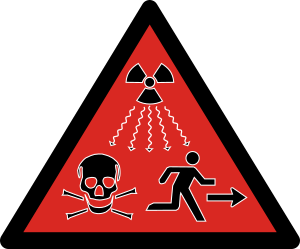
The IAEA has noted a continuing problem with the illegal movement, theft, or loss of nuclear and other radioactive materials. This means that these dangerous materials sometimes go missing or are stolen.
For example, in 2007, burglars broke into a nuclear research facility in South Africa but did not get any uranium. In 2006, a man was arrested in Georgia with highly enriched uranium. These incidents highlight the need for very strict security to prevent radioactive materials from falling into the wrong hands.
Types of Nuclear Accidents
Nuclear Meltdown and Core Damage
A nuclear meltdown is a very serious accident where a reactor's core gets so hot that it melts. This happens when the cooling systems fail and the heat from the nuclear fuel becomes too much. A core melt can be caused by a loss-of-coolant accident, or by the reactor running at a power level higher than it was designed for.
Major nuclear meltdowns at power plants include:
- The Three Mile Island accident in the United States in 1979.
- The Chernobyl disaster in Ukraine in 1986.
- The Fukushima Daiichi nuclear disaster in Japan in 2011.
Criticality Accidents
A criticality accident happens when a nuclear chain reaction starts by accident in fissile material, like enriched uranium or plutonium. This means the material starts splitting atoms on its own, releasing a lot of energy and radiation. The Chernobyl accident involved a runaway chain reaction. A smaller accident happened in Tokaimura, Japan, in 1999 during fuel production, where two workers died and many people were exposed to radiation.
Decay Heat Issues
Decay heat is the heat produced by radioactive materials even after a reactor is shut down. If this heat isn't removed, the reactor core can get dangerously hot. This is a big safety concern, especially right after a reactor stops working.
For example, at Three Mile Island Nuclear Generating Station, a reactor was shut down but left without enough cooling water. This damaged the nuclear fuel and caused a partial meltdown. In 2011, an earthquake and tsunami caused a power loss at the Fukushima Daiichi plant. The decay heat could not be removed, leading to meltdowns and the release of radioactive materials.
Transport Accidents
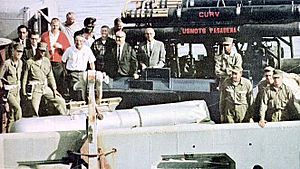
Accidents can happen when radioactive materials are being moved. This can cause radiation to leak or protective shielding to break. For instance, in Bolivia, a faulty gamma radiography device was carried on a passenger bus. The radiation source was outside its shield, exposing some passengers.
In 1966, a U.S. Air Force bomber carrying nuclear weapons crashed off the coast of Spain. Two of the weapons' non-nuclear explosives went off, spreading radioactive plutonium over a large area.
Equipment Failure
Sometimes, machines or systems can break down, leading to accidents. In Poland in 2001, a particle accelerator used for cancer treatment had an electronic malfunction. This caused at least one patient to receive too much radiation. Even a small part failing can lead to a chain of events causing harm.
Human Error
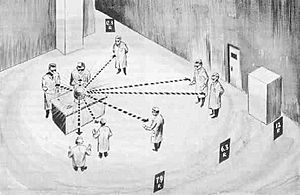
Many major nuclear accidents have happened partly because of human mistakes. At Chernobyl, operators did not follow safety rules during a test. At Three Mile Island, operators allowed a lot of cooling water to escape, which damaged the reactor.
In 1946, a scientist named Louis Slotin was doing a risky experiment with radioactive materials. He accidentally caused a chain reaction, exposing himself to a deadly dose of radiation. He died nine days later. This shows how careful people must be when working with these materials.
Lost Sources
Lost source accidents happen when a radioactive source is lost, stolen, or left behind. These "orphan sources" can then harm people who find them. The 1987 Goiania accident in Brazil is a famous example. A medical radiation source was forgotten in a hospital, then stolen and opened by people looking for scrap metal, causing serious contamination.
Experts believe that up to 50 nuclear weapons were lost during the Cold War.
Comparing Energy Safety Records
When we compare the safety of nuclear energy with other ways of making electricity, studies show that nuclear power has a good safety record in terms of direct worker deaths. However, nuclear power plant accidents can be very expensive to clean up.
For example, coal power plants are estimated to cause many deaths each year due to lung diseases. Coal plants also release more radiation into the environment than nuclear plants, in the form of fly ash. Hydroelectric plants have also caused many deaths in major dam failures.
Ensuring Nuclear Safety
Nuclear safety involves all the actions taken to prevent nuclear and radiation accidents or to limit their harm. This includes safety at power plants, during transport of materials, and in medical or industrial uses.
The nuclear industry has made reactors safer and developed new designs. However, there's no guarantee that reactors will always be designed, built, and operated perfectly. Mistakes happen. For example, at Fukushima, designers did not expect a tsunami to disable the backup systems after an earthquake. This shows that even advanced economies need to be very careful with nuclear safety.
Older nuclear reactors need more monitoring and maintenance to stay safe. These measures can be costly. To improve safety, some suggest building new, safer reactors and retiring older ones. Many companies are working on innovative, safer, and more affordable nuclear plant designs.
Ecological Impacts of Accidents
Impact on Land
When radioactive materials are released during an accident, they spread into the air and then settle on the ground. These materials can stay in the top layer of soil for many years because they decay slowly. This can harm agriculture, farming, and livestock, which can affect human health long after the accident.
After the Fukushima Daiichi accident in 2011, nearby farmlands were contaminated with high levels of cesium. This greatly limited food production in eastern Fukushima. Similarly, the Chernobyl disaster in 1986 contaminated a huge area of land across Ukraine, Belarus, and Russia. Many plants could not reproduce for several years.
Impact on Water
Radioactive materials can also get into water systems. After the Fukushima Daiichi accident, contaminated groundwater was found near the facility and in the ocean. The Tokyo Electric Power Company (TEPCO) confirmed that this contamination was due to the 2011 earthquake. The Fukushima plant released nuclear material into the Pacific Ocean, and after five years, traces reached all corners of the Pacific. While radiation levels increased, they generally remained below levels considered dangerous for drinking water by the World Health Organization.
The Chernobyl accident also caused widespread water contamination. Radioactive particles settled in groundwater systems in the surrounding areas and in neighboring countries. This led to radioactive materials being absorbed by plants and then moving up the food chain into animals and humans. One of the main ways people were exposed was through eating farm products contaminated by radioactive groundwater. Flooding in the region also posed a risk, as it could spread radioactive materials from the floodplains.
Impact on People
Exposure to ionizing radiation can increase the chance of developing cancer later in life. Scientists study these effects to understand the long-term health risks.
See also
 In Spanish: Accidente nuclear para niños
In Spanish: Accidente nuclear para niños
- European Committee on Radiation Risk
- International Nuclear Event Scale
- Nuclear power debate
- Acute radiation syndrome
- List of military nuclear accidents
- Radiation poisoning (disambiguation)


